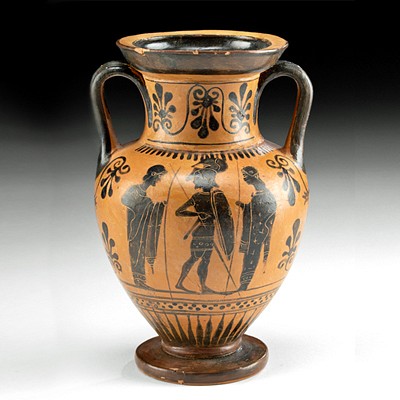A.D.M. Cooper Chromolithograph - "Burning Arrow" (1904)
Lot 256
About Seller
Artemis Fine Arts
686 S Taylor Ave, Ste 106
Louisville, CO 80027
United States
Selling antiquities, ancient and ethnographic art online since 1993, Artemis Gallery specializes in Classical Antiquities (Egyptian, Greek, Roman, Near Eastern), Asian, Pre-Columbian, African / Tribal / Oceanographic art. Our extensive inventory includes pottery, stone, metal, wood, glass and textil...Read more
Categories
Estimate:
$2,400 - $3,600
Absentee vs Live bid
Two ways to bid:
- Leave a max absentee bid and the platform will bid on your behalf up to your maximum bid during the live auction.
- Bid live during the auction and your bids will be submitted real-time to the auctioneer.
Bid Increments
| Price | Bid Increment |
|---|---|
| $0 | $25 |
| $300 | $50 |
| $1,000 | $100 |
| $2,000 | $250 |
| $5,000 | $500 |
| $10,000 | $1,000 |
| $20,000 | $2,500 |
| $50,000 | $5,000 |
| $100,000 | $10,000 |
| $200,000 | $20,000 |
About Auction
By Artemis Fine Arts
Mar 9, 2023
Set Reminder
2023-03-09 10:00:00
2023-03-09 10:00:00
America/New_York
Bidsquare
Bidsquare : Exceptional Ancient, Ethnographic, & Fine Art
https://www.bidsquare.com/auctions/artemis-gallery/exceptional-ancient-ethnographic-fine-art-12354
Artemis Fine Arts info@artemisfinearts.com
Artemis Fine Arts info@artemisfinearts.com
- Lot Description
**First Time At Auction**
Astley David Middleton (A.D.M.) Cooper (American, 1856-1924). "The Burning Arrow" or "Flaming Arrow" chromolithograph, 1904. An original, antique chromolithograph of "Burning Arrow" (aka "Flaming Arrow") - one of A.D.M. Cooper's most famous paintings. Cooper is best known for his depictions of indigenous peoples with whom he lived in the American West when he was in his early twenties. "Burning Arrow" depicts a group of warriors using a flaming arrow to signal their movements to a distant Indian camp during the Great Sioux War (also called The Black Hills War and known for the famous Battle of Little Big Horn) of 1876 to 1877. Starting at the top and in clockwise order, the figures depicted are as follows: Bull Head (son of Sitting Bull) is the man firing the arrow; Chief Hard Heart is standing with his back to the fire; Sitting Bear is on the ground sitting watching the arrow in flight; Lone Wolf, Buffalo Head, Standing Bear, and two unnamed Indians in the background are also depicted. A remarkable, large-scale, original antique chromolithograph that likely took months to create given its extensive composition and coloration - mounted in an exceptional frame that was artistically designed with carefully selected, museum-quality materials. Size (sight view): 19" L x 25.5" W (48.3 cm x 64.8 cm) Size (frame): 32.625" L x 38.875" W (82.9 cm x 98.7 cm)
A.D.M. Cooper objected to the American Indian Wars and was greatly respected by the indigenous peoples. Cooper exhibited "Burning Arrow" at H.A. Meldrum Company's Free Art Gallery at the Pan American Exposition of 1901 in Buffalo, New York. Cooper's models for this painting included six prominent Sioux Indians who participated at the Indian Congress at the Midway at the Pan Am Expo in addition to two other Sioux Indians. Starting at the top and in clockwise order: Bull Head (son of Sitting Bull) is the man firing the arrow; Chief Hard Heart is standing with his back to the fire; Sitting Bear is on the ground sitting watching the arrow in flight; Lone Wolf, Buffalo Head, Standing Bear, and two unnamed Indians in the background are also depicted.
Interestingly, Cooper first exhibited his 9' x 12' painting of "Burning Arrow" at the Exhibition Hall of the Emporium and Golden Rule Bazaar in San Francisco beginning on January 31, 1900. According to the advertisement in the "The San Francisco Call" newspaper on that date: "'The Burning Arrow'—a realistic painting of an episode of the Sioux-Custer war, by A.D.M. Cooper, a well-known painter of Indian pictures—on free exhibition to-day and until further notice in Exhibition Hall, second floor. The canvas is 9x12 feet in size. Aside from its artistic merits, it will be of special interest to every boy and girl who is studying the history of this country."
Chromolithography was invented by lithographers as a means of printing on flat surfaces by using chemicals instead of relief or intaglio printing. A chromolithograph like this one took months to produce, depending on the number of colors in the image.
Provenance: private Colorado Collection; Private Collection of a Private Colorado Family
All items legal to buy/sell under U.S. Statute covering cultural patrimony Code 2600, CHAPTER 14, and are guaranteed to be as described or your money back.
A Certificate of Authenticity will accompany all winning bids.
We ship worldwide and handle all shipping in-house for your convenience.
#176982This is an original antique hand-colored lithograph. It is not a later reproduction. It is mounted in a custom, museum-quality frame behind glass. While not examined outside the frame, it appears to be in outstanding condition with vivid imagery and hand coloring. Framing is of an impressive design, made with carefully selected, museum-quality materials. Frame has a few minute (nearly invisible) scuffs, but is otherwise excellent, fit with suspension wire, and ready to display.Condition
- Shipping Info
-
All shipping is handled in-house for your convenience. Your invoice from Artemis Gallery will include shipping calculation instructions. If in doubt, please inquire BEFORE bidding for estimated shipping costs for individual items.
-
- Buyer's Premium



 EUR
EUR CAD
CAD AUD
AUD GBP
GBP MXN
MXN HKD
HKD CNY
CNY MYR
MYR SEK
SEK SGD
SGD CHF
CHF THB
THB














